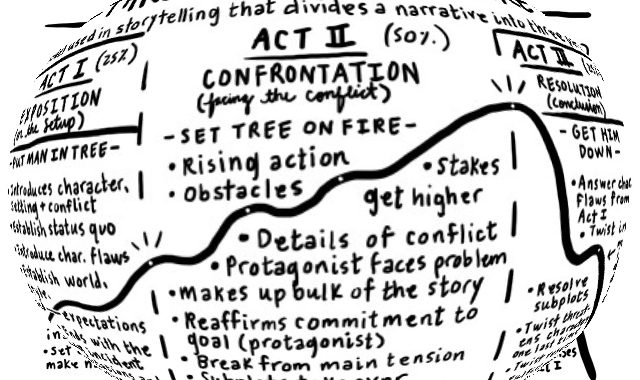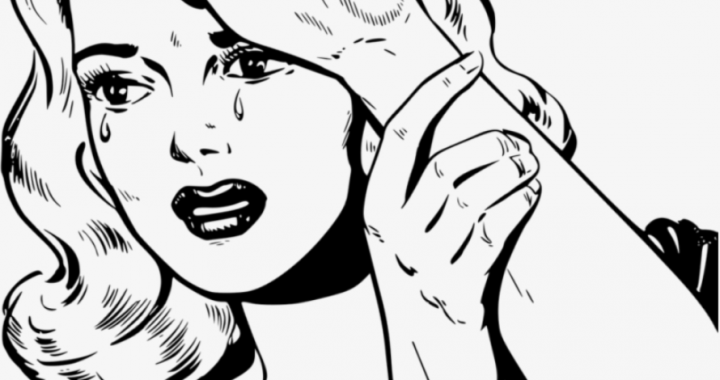Now we enter chapter 2. It’s the point of no return! The part after the beginning and the part before the end, the “muddle” as the author cites. Lol. The muddle. I’ve always been shy of my muddles. What do I do? I tattoo them with references. I slash them to bits and insert and delete prose. It’s terrible difficult to keep one interested in the muddles.
Reminds me of how when I tell a joke at a table, even if it’s a killer joke where everyone ends up laughing, or everyone starts off graphically engaged . . . I find it hard to keep eye contact here. Maybe I am scared of the middles. Act IIs . . . Mr Bell help a boy out!
Anyway, as we pray, let us write, train and flex, and complete the next exercise. Wait! One last note. Mr Bell recommends these three parts not be super equally spaced, in fact the first act should end somewhere at the 1/5 mark, and the last ask should begin at the 4/5 mark. It’s almost as if he prepares us to write in 5 acts. Another note: instead of calling them “plot points” as I heard in the MFA, or “inciting incident” which sounds vague and needlessly saccharine . . . Mr Bell calls for us to view “transitions from beginning to middle” and “transitions from middle to end” as door ways. Doors of no return. And “disturbances,” as opposed to incident. Probably because an incident I can get over, or ignore. But a disturbance will %^*& me up.
Ok ok . . . here it is. Noooooo, waitttttt!!!!! I gotta say another thing. After reading this chapter, I told myself, “fine 3 acts are the way to go.” Why this change? Mr Bell kept hammering the point, hammering the point, hammering the point about writing in three acts. I was about to suffer a yawn stroke. What if, I wondered, we are just overlaying the three acts (like a transparent sheet of paper over a projector) over everything? Suddenly I turned to the speakers besides my laptop. Their design follows the three acts! One tweeter could be cut in three parts beautifully. The label of the water bottle at my desk too. Even how I naturally arranged my wife’s stuffed animals . . . the Argentine flag . . . everything.
Fine. Maybe the three act structure is in everything because it survives. The triangle survives. Attack it, but it bites back. Try to crush it, and is corner stings you. And like an ex-roommate once said, “Three is the number of the universe,” talking about threesomes, lol. Anyway, let us get to it, shall we?
. . .
Analyze some novels or movies with a view toward understanding their three-act structure. (For this I will use a Murakami short story, a Cortázar short story, Fitzcarraldo, and Forrest Gump.) Specifically note:
What is the disturbance to the lead’s ordinary routine? What change happens early on? (If it doesn’t, does the book or film seem to drag?)
The Birthday Girl: the protagonist must work on her birthday, even after her coworker offered to cover for her, because of a last minute fever. (Doubtful, the coworker may be lying.) Zero drag, because it happens on the first page. It’s a disturbance because the plan was for her to stay home. But it isn’t a doorway because there is no confrontation with any force yet. (That happens when she meets her boss for the first time.)
La salud de los enfermos: It’s a story about a family that keeps the news of the death of a son from his mother. She is herself sick, and about to die, and no one wants to ruin the last months of her life. The disturbance to this secret arrangement among all the family members happens on page when, when another niece gets sick, and they must lie some more. Zero drag, 100% excitement.
Fitzcarraldo: the disturbance happens pretty late in the film, when the protagonist realizes ice isn’t a lucrative enough business in Peru to fuel his ambitious project. For a bunch of the film, it’s pretty status quo, even though it does happen around the 30-min mark, and overall the film rocked.
Forrest Gump: I’d say the disturbance here was a positive one, and it’s when the mother sleeps with the principal of the public school, in order to give her son an equal opportunity at life. Up until then everyone had seen him as below average. Now he has a shot at being normal.
At what point is the lead thrust into conflict? At what point can he not return to normal?
BG: When the restaurant manager goes to the hospital, thus cannot bring the food to everyone’s mysterious boss. The responsibility falls on the protagonist. There is no other option. The plot thickens.
SE: by the time the reader is all caught up in the lie, a huge doorway happens when the dead son’s girlfriend stops playing the charade, and now the whole family must lie about her too.
Fitz: When the protagonist embarks on his journey on his newly acquired boat. He goes all in, and must succeed or die trying . . . even though we are not sure what it is he is trying to do, we hope that it will bring him enough money to achieve his real dream.
FG: The whole movie is a series of twists where the protagonist proves himself. But I would say the main one is going off to fight in the Vietnam war. Only because before that, he could have been anybody, done any occupation. But becoming a soldier sort of defines his character for the rest of the movie. Bullet in the butt aside, he returns home set on getting married to Jenny, on realizing Bubba’s dream, and on being a good person.
When is there a major clue, or crisis or setback that makes the crisis inevitable?
BG: When the protagonist makes her birthday wish. Although we never hear what it is (and, cmon are we supposed to know someone’s wish?) the remaining three or four pages contextualize that wish.
SE: When it’s official that the mother is going to die very soon, everyone takes a deep, deep breath. Up until then it seemed she was recovering from her illness, implying that the family would need to confess the truth about her son’s death. But in the last pages, her health takes a turn for the worst. And she dies, successfully doped. Although, her weak brain, babbling, makes us feel like maybe just maybe she knew all along the family had lied to her.
Fitz: The night after the natives and the protagonist’s crew get the boat over the mountain, they celebrate hardcore. But, then, the elders of the tribe cut the boat’s ties to land, and send them on a near-death collision with dangerous rapids. Whatever happens after that rope is cut is the falling action to certain death for a crew who had done the impossible.
FG: Once we find out why the protagonist has been waiting at that bus stop and that Jenny lives right around the corner. This pretty much gives us what we wanted. Their destined union. Although, some inevitable stuff happens . . . it’s really the tying up of all the threads in the story.
If you’re bored, ask yourself if the LOCK or three act structure is weak.
BG: Wow, here is an example of a pretty bad LOCK that wins me with a great three act structure. I’m not really into the lead, her objective is never revealed, there is conflict but only psychological and spiritual, while the knockout at the end is to our own face when we are denied the wish. Each thwarted LOCK element, I suppose, appeared in the right order. If we came to find out the importance of the LOCK elements different, the story would have have knocked us in the face at the end.
SE: Never bored, and the elements work fantastically. I was flipping like mad trying to find out what happens. Probably the certain death of the senile mother guaranteed from the beginning, paired with the lingering death of her son which everyone tries to hide from her, made this a thrilling and interesting story to read. (The mark from middle to end, in fact, is when the family convinces the son’s girlfriend to return to the family farce.)
Fitz: Boy did this story drag in the beginning. Not sure why, maybe there was too much lead, and not a strong enough O in the first act. Herzog should have put him on the boat earlier. But then again, the middle and the end are soooo strong, that we forgive the artist for excelling painting 19-century Peru. Perhaps, if learning that Fitz’s deepest wish is to have an opera house, then what would happen to him if he never gets the opera house? As a viewer I’m thinking, chill dude, if you get it or not you still have a babe girlfriend and a wacky rich best friend. A bigger stake, I suppose.
Damn. I make the same mistakes though in my writing . . .




